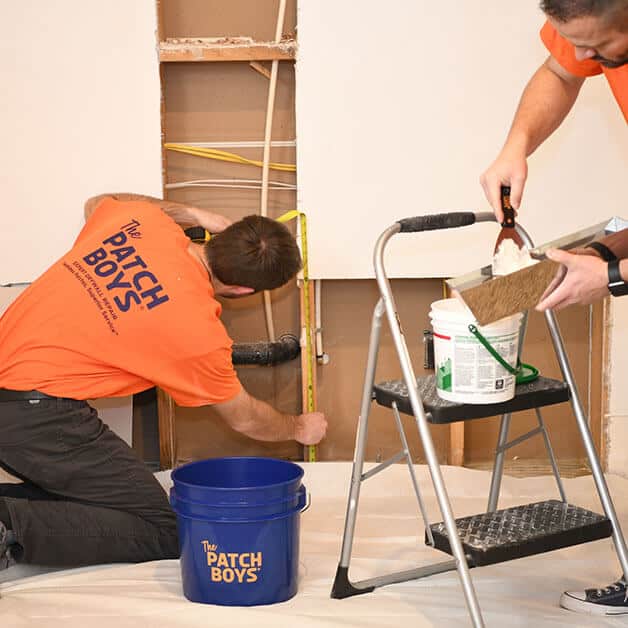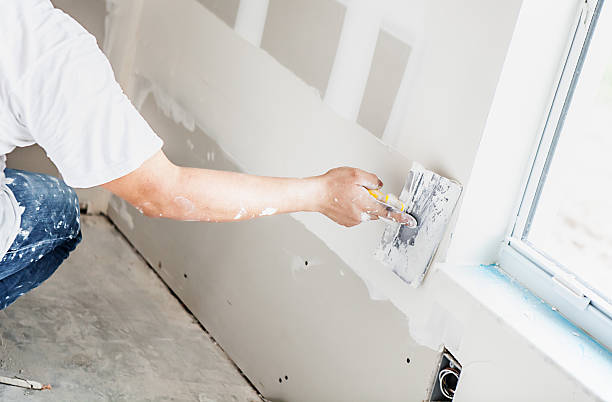Selecting the Right Drywall Contractors for Your Job
Wiki Article
Mastering the Art of Drywall Setup: Proven Approaches for a Perfectly Smooth Surface
In this discussion, we will certainly discover the tried and tested approaches that can assist you grasp the art of drywall setup and attain that flawlessly smooth finish you want. From preparation and preparation to the final finishing touches, we will certainly dive right into the essential actions and methods that will elevate your drywall installment video game.
Preparation and Preparation
Proper preparation and thorough prep work are necessary for an effective drywall installation task. Before beginning the setup process, it is critical to very carefully assess the room and establish the required materials and devices. This preliminary step establishes the foundation for a smooth and reliable task.To start, exact measurements of the location are important. This makes certain that the appropriate quantity of drywall is purchased, protecting against delays or added expenses as a result of material scarcities. Furthermore, it is critical to examine the wall surfaces for any existing damages or disproportion. Dealing with these concerns before setup will certainly result in a much more refined and specialist finish.
Next, a detailed layout strategy need to be developed. This plan includes the positioning of the drywall panels, considering any kind of openings for doors, home windows, or electric outlets. By creating a comprehensive layout, potential issues or difficulties can be determined and resolved prior to the installation procedure begins.
Preparation of the workspace is also necessary. drywall contractors. This consists of removing the area of any type of furnishings or items that may hinder the setup process. Additionally, safeguarding the floors and surrounding surface areas with ground cloth or plastic sheets will avoid damages and make clean-up less complicated
Tools and Materials
To make sure a successful drywall setup job, it is vital to have the needed tools and materials on hand. Having the right devices will not just make the work much easier however also ensure a exact and expert finish. The adhering to are a few of the key tools needed for a smooth drywall setup:- Measuring tape: Exact measurements are crucial for a smooth setup. A gauging tape will certainly help you determine the measurements of the drywall sheets and ensure they fit flawlessly.
- Energy knife: A sharp energy knife is crucial for cutting drywall sheets to the desired dimension. It should be made use of to score the front paper layer and afterwards snapped along the racked up line for a clean cut.
- Screw weapon: A screw gun or pierce with a drywall screw attachment is required to secure the drywall sheets to the studs or framework. It allows for fast and efficient setup of screws without harming the drywall.
- T-square: A T-square is used to make certain exact and straight cuts when marking and racking up the drywall sheets.
- Joint substance: Also called mud, joint substance is used to cover and hide the seams in between drywall sheets. It is crucial to choose the ideal kind of joint compound for the certain task, such as ready-mixed or setting-type.
Along with these tools, it is likewise vital to have the necessary materials, consisting of drywall screws, joint tape, edge beads, and sandpaper. By having the right tools and materials, you will certainly be well-prepared for an effective drywall installation job.
Gauging and Reducing Drywall
Precise dimensions and specific cutting are vital for an effective drywall installment task. Before cutting the drywall, it's important to gauge the location where it will certainly be installed accurately. Begin by utilizing a gauging tape to determine the height and width of the wall. Tape-record these dimensions and after that move them onto the drywall sheet. Make use of a straight edge, such as a T-square, to create straight lines for cutting.To make it procedure less complicated, rack up the drywall along the dimension lines making use of an energy blade. Apply solid pressure to develop a superficial groove in the drywall surface area. After that, carefully break the drywall along the racked up line by flexing it away from the scored side. Finish the reduced by making use of the energy knife to trim any continuing to be paper and plaster.
When reducing openings for various other fixtures or electrical outlets, action drywall contractors and note their settings on the drywall sheet. Use a keyhole saw or a drywall saw to meticulously reduce along the significant lines, guaranteeing the openings are tidy and precise.
Bear in mind to use safety goggles and gloves while cutting drywall to shield yourself from any kind of prospective injuries. By following these actions and taking accurate dimensions, you will achieve exact cuts, resulting in a professional-looking and smooth drywall setup.
Putting Up and Getting Drywall
After efficiently cutting the drywall and gauging, the next action in the installment process is safeguarding it in place. Effectively securing the drywall makes sure a durable and steady installment that will stand the test of time. There are numerous methods to think about when it comes to setting up and safeguarding drywall.One common technique is to make use of drywall screws. These screws are specifically created for drywall installation and have a sharp point that quickly passes through the drywall and a crude thread that supplies solid holding power. When using screws, it is essential to drive them in simply adequate to secure the drywall without breaking the paper surface area. Overdriving the screws can result in dimples or perhaps pierces externally of the drywall.
Another method is to use drywall nails. Nails are typically made use of for short-lived setups or in areas where screws can not be used. However, nails often tend to have much less holding power compared to screws and can possibly bulge in time. It is necessary to utilize the appropriate dimension and size of nails for the job and to room them properly to guarantee a secure installment.
In addition to nails and screws, adhesive can also be made use of to secure drywall. Drywall adhesive is related to the studs or other surface areas before positioning the drywall, giving an additional layer of attachment. This technique is specifically valuable for ceilings or bent wall surfaces where the weight of the drywall can trigger it to sag or flex.
Despite the technique made use of, it is crucial to make sure that the drywall is appropriately protected and flush versus the studs or various other surfaces. This will certainly stop drooping, breaking, or other problems that can occur with time. By complying with these shown techniques, you can accomplish a perfectly smooth surface and master the art of drywall installation.
Ending Up Techniques and Accomplishing a Smooth Surface
After the drywall setup process is full, the next step is to prepare the surface area for painting or wallpapering. Sanding should be done meticulously, making use of a fine-grit sandpaper, to avoid harming the drywall. By using these completing methods, a completely smooth surface area can be attained on drywall, guaranteeing a professional and aesthetically pleasing outcome.Verdict
Finally, understanding the art of drywall setup requires cautious preparation, exact measuring and cutting, and competent ending up techniques. By adhering to tested approaches and using the right devices and materials, one can accomplish a flawlessly smooth surface. Focus to detail and appropriate installment and securing of the drywall are crucial for a successful job. With technique and persistence, any person can become efficient in this craft.
After the drywall setup procedure is total, the next step is to prepare the surface area for paint or wallpapering.
Report this wiki page